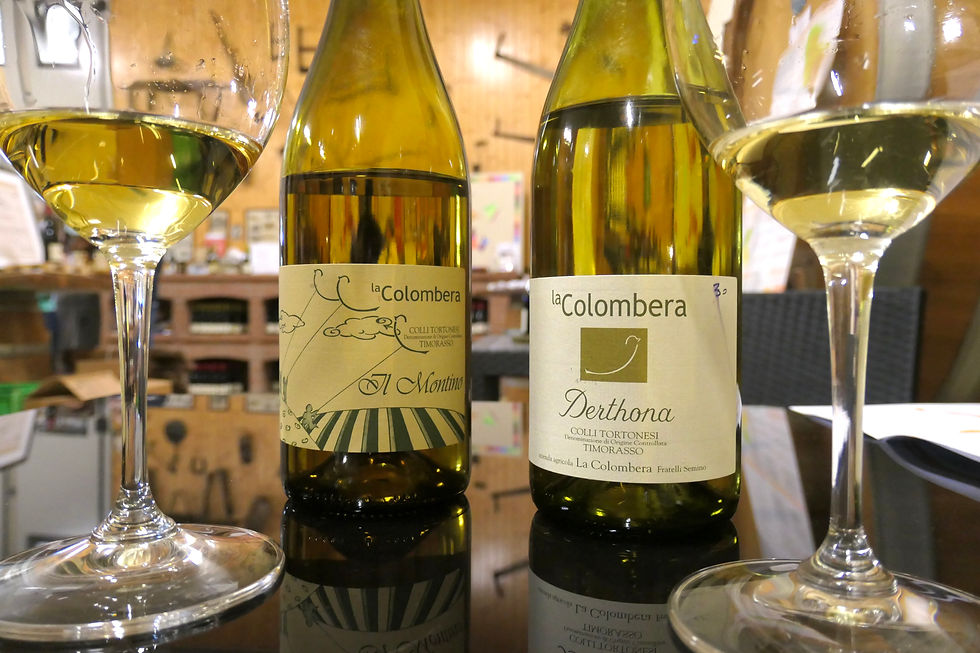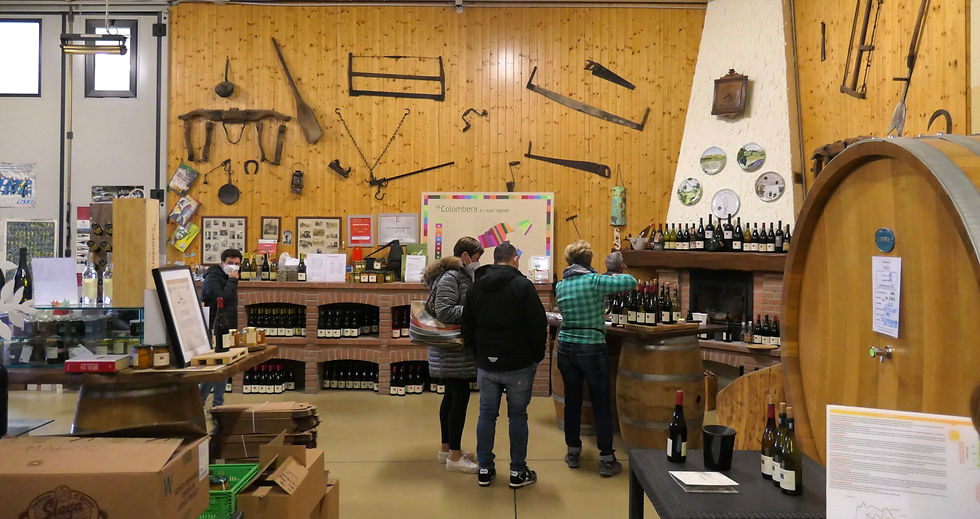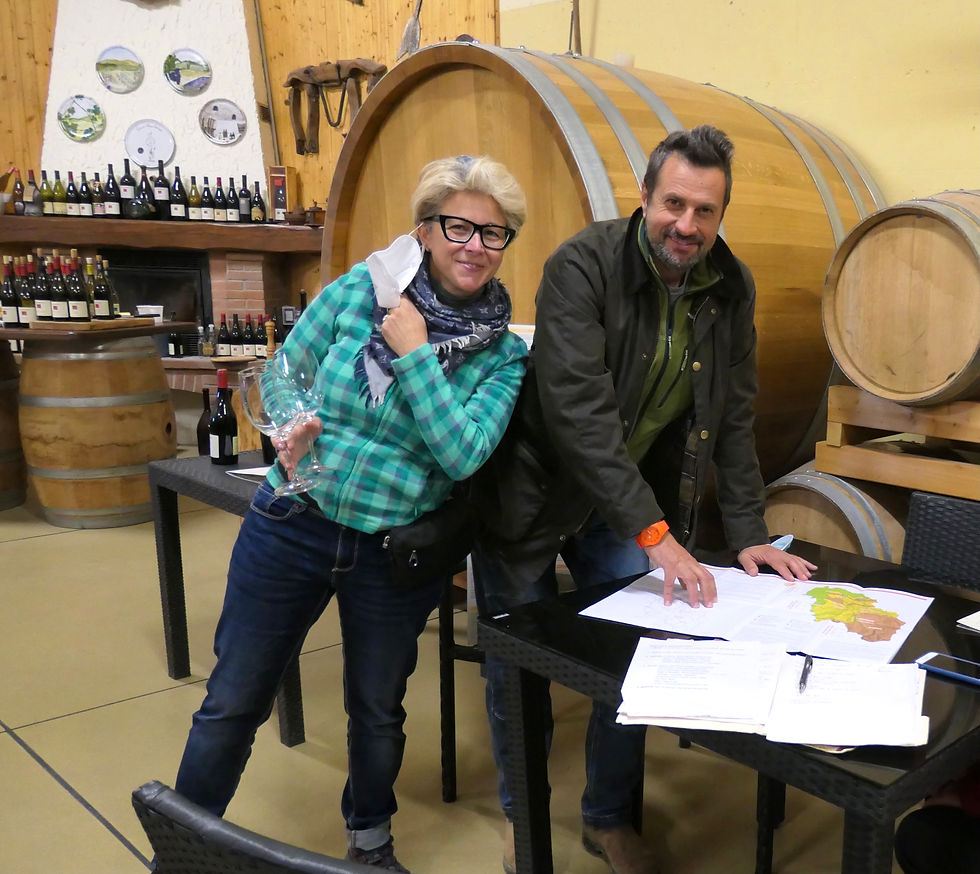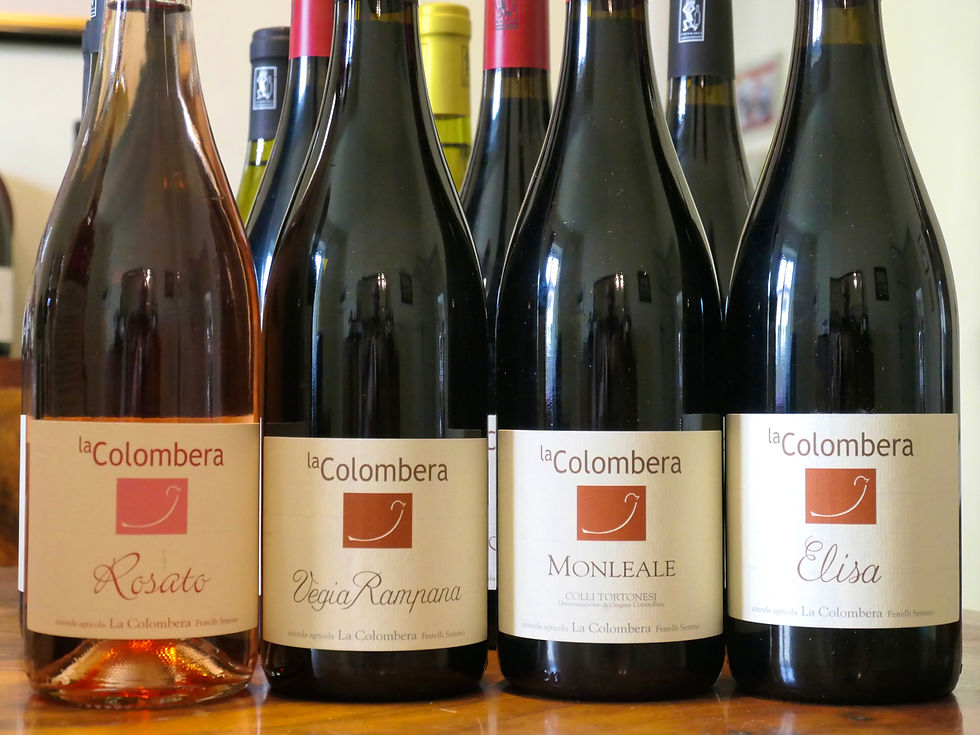La Colombera, Tortona
- Mike
- Dec 17, 2021
- 13 min read
Updated: Apr 13, 2024

We arrived at La Colombera on the last day of October under leaden skies with winter already in the air. It was not long after breakfast on a Sunday morning so we were expecting an empty tasting room with Elisa Semino all to ourselves for an hour. Wishful thinking on our part because such is her popularity and the reputation of her wines that we had to share her with a steady stream of visitors, or maybe it was because her only competition for customers at that hour of the week was a cold, draughty church.
This is not a complaint, far from it, as we then had the opportunity to observe her in her natural environment, happily dispensing wine and wisdom in equal measure to appreciative locals, and all done with a smile and obvious enthusiasm. Nor in fact did she neglect us, returning to our table every few minutes to answer another question and open yet another bottle of her dizzying range of twelve different wines.

A young girl (Elisa’s niece as we subsequently discovered) then appeared at our table with a plate of bread and two of the wonderful culinary delights of this area of south-east Piedmont: Montebore cheese (which 533 years ago was fashioned into a wedding cake for Isabella d’Aragona and because of its shape was thereafter known as the ‘wedding cake' cheese) and the noble salami of Giarolo.
As I munched on the salami and sipped the Barbera in front of me I was reminded of why Elena goes on at length about food and wine matching, because the acidity that some people find objectionable in a young Barbera melts away when pared with a fatty local product like the Giarolo salami. When in doubt in Italy the best advice is always to drink local wines with local foods.
I heard during our visit that Elisa is constructing a new tasting room, which is a pity because sitting amongst barrels of wine and giant tanks of vino sfuso with bottles and boxes everywhere is the perfect backdrop for a convivial wine tasting, providing just the right atmosphere.

It’s not obvious exactly where Tortona is, even when you’re actually there, because it’s a historical crossroads of sorts between regions. If you were to drive the 90 miles from Milan to Genoa then you would pass right by Tortona at exactly the half way point.
To the west are the wine towns of Alessandria and Asti and to the east lies the Po valley (Pianura Padana) stretching all the way to the Adriatic. The Roman Via Postumia passed through Tortona, which was called Derthona at that time, on its way from Genoa to Verona. So while Tortona is located in Piedmont it’s very close to three other regions, Lombardy, Emilia Romagna and Liguria.
Our route here took us through the nearby town of Spinetta Marengo which was the site of Napoleon's famous victory over the Austrians in 1800, a closely contested battle that was to cement Napoleon's political power in Paris and which drove the Austrians out of north west Italy.
The Colli Tortonesi are a series of hills and valleys that start a little north of Tortona and run mostly south-east to the Ligurian border where the much higher Appennine mountains take over. The Colli Tortonesi DOC was created in 1973 and includes 47 municipalities across 7 valleys, all in the province of Alessandria.
There are only 2,000 acres under vine because this has always been a very diverse agricultural area with orchards, chick peas, cereal crops, forests and meadows. To the naked eye it’s certainly more naturally pastoral than the never ending vines of the more famous Italian wine producing areas, which makes it also much healthier in terms of biodiversity. The principal grape varieties grown in the Colli Tortonesi are Barbera with 55%, Timorasso at 11% and then Cortese, Dolcetto and Croatina.

Elisa Semino grows them all and makes more than one wine from each type of grape though she is most famous for her two Timorasso wines. This is a grape that was close to extinction until the 1990s when it was revived by a handful of winemakers under the leadership of Tortona native Walter Massa. His first pure Timorasso wine was in 1987 from barely more than an acre of vines and this was followed by some difficult years as it is not an easy grape to grow.
It ripens unevenly and must be harvested quickly as soon as it’s ready because there is a very short window when it's at its best. Massa held tight to his conviction that this grape was a noble variety with the potential to make a very good white wine that was also capable of aging into something truly splendid and he was eventually proved right. His theory was that in the years prior to 1987 Timorasso had been planted in all the wrong places, often at higher elevations, with the best spots being given to Barbera and Cortese.
Timorasso had not been given a fair chance to show its potential because after the phylloxera devastation in the 1880s Timorasso was largely abandoned in favor of the much easier and more productive Cortese grape, a trend that continued after 1945 with a growing preference for red wines and the depopulation of the Italian countryside.

However, the Timorasso grape goes back centuries in Piedmont, at least as far as 1489 with Isabella d’Aragona’s marriage into the powerful House of Sforza and the wedding banquet that took place in Tortona on the way to Milan.
Ludovico Sforza was Leonardo da Vinci’s employer at the time and da Vinci’s initial role for his Milanese benefactor was as a producer of elaborate pageants (see Chapter 6 of Walter Isaacson's very well researched da Vinci biography published in 2017), so responsibility for the dazzling banquet fell to him. Ludovico was known to be a lavish spender and as records suggest that Timorasso wine was served at the wedding, we can only assume that it must have been an exceptional wine all those centuries ago.

A well-known American wine critic wrote recently that “one trend I am not a fan of is the recent infatuation over Timorasso……..to be sure, the finest examples can be compelling. But they are the exception. Why producers in Barolo and Barbaresco, who have some of the world’s greatest vineyards in their backyards, would bother with what is, quite frankly, a second-class variety is beyond me”.
Anyone who has tasted Elisa’s two Timorasso wines certainly wouldn’t dismiss them as being from a second class grape variety and not for nothing was she given the sobriquet 'Queen of Timorasso' by a magazine recently. Like her mentor Walter Massa, her belief is that Timorasso is a great Italian grape varietal that can produce long lived wines with notable minerality and she is not the only one optimistic about the potential of this grape as there are now almost 50 different producers of Timorasso.
As the critic correctly noted, many famous Nebbiolo growers are now buying land in the Colli Tortonesi, particularly around Monleale and Sarezzano, but Walter Massa’s much less critical reaction recently was to say “the fact that people who produce Barolo and Barbaresco and sell it all over the world are interested in our white wine can only do the territory good ”.

The problem highlighted by this difference of opinion is that few professional wine critics (one notable exception being Ian D’Agata) can be bothered with many of the interesting and unique Italian native grape varieties because their publications exist to serve the interests of their somewhat myopic subscriber base rather than provide visibility to the wider Italian wine industry and too many of their subscribers are fixated on a limited range of famous Italian ‘trophy’ wines. The story of Timorasso, like other similar ones we have written about, is what makes the Italian wine landscape fascinating and unique.
The community of Timorasso winemakers today remains very collegial as befits a grape that was nurtured back to life by a small group of dedicated people in the face of initial skepticism and disinterest. Elisa Semino’s history with this grape goes back to those early years, starting with her oenology degree thesis on Timorasso in 1996 and her first Timorasso plantings the next year. She realized quite early that a Timorasso wine can improve dramatically with age, but as it tastes so good young and production is so small I wonder how many people will ever get to drink it at 7 or 8 years old.
In 1998 her first wine was produced under the La Colombera label and then two years later she picked her very own Timorasso grapes for the first time as one of only 5 wineries actively making this wine twenty-one years ago. 2006 was another milestone year for her with the initial production of the single vineyard ‘Montino’ Timorasso bottling. The Montino cru was the result of years of research and sensory analysis involving their five different vineyards planted over the previous nine years.

La Colombera today remains a diversified farming operation first started by Elisa’s grandparents in 1937, subsequently enlarged by her father Piercarlo in 1980 and it was also Piercarlo who first started to make his own wine instead of selling his grapes. A very familiar Italian story by now. Elisa is the oenologist and winemaker and her brother Lorenzo looks after the farming, together with Piercarlo. In addition to the vineyards, which produce 80,000 bottles per annum, there are 80 acres of wheat, chickpeas and various orchards, including their own production of the famous Volpedo peaches.
The vineyards are farmed organically (but not formally certified as such) and it has been over 10 years since any pesticides have been used. We have remarked in previous articles about the negative implications of climate change and the move to higher elevations in Tuscany and elsewhere to preserve acidity but here in fact Timorasso is a beneficiary of more heat in summer, making it a more reliable grape.
We also spent some time with the winery’s agronomist, Davide Ferrarese, who is in the process of constructing a very useful topographical map of the entire Colli Tortonesi and he educated us on the different soil types of all the zones within the DOC. Around Tortona the preponderance of clay soils rich in chalky limestone and marine fossils, often with a surface layer of sand, is very similar to much of Barolo further west, especially La Morra where they also talk of the marl of Sant'Agata. The climate however is quite different, with the Tortona area being hotter and less rainy which generally leads to earlier ripening of the grapes.

As a winemaker Elisa is at the top of her game right now with the experience and confidence that comes from two decades of harvests under her belt. She is making excellent wines at very fair prices but clearly has no intention of resting on her laurels. New acreage nearby in Sarezzano that was purchased in 2017 and planted mostly to Timorasso will be harvested for the first time in 2022 so the future looks very bright, especially as the soil there is very similar to the Il Montino vineyard.
Timorasso is clearly the wine that defines Elisa in the wine world and she has picked a wonderful grape with which to demonstrate her talents as a winemaker. Lots of people make excellent Barbera but very few can match her skill with Timorasso and it's only a matter of time before the Colli Tortonesi and La Colombera wines become very popular with the wider wine drinking public and it will be richly deserved.
After our visit to La Colombera I discovered more about the fabulous Montebore cheese. Apparently, just like the Timorasso grape, this cheese was almost extinct as recently as 1997, which given its 1,000 year history would have been an inexcusable cultural loss for Italy.
It was saved when a member of the local Slow Food organization (which was started in Piedmont) and a local cheesemaker tracked down the last known producer of this cheese, a 70 year old woman at that time, by the name of Carolina Semino Bracco and begged her to teach them how to make it in the traditional fashion. Bracco had moved to Montebore in 1951 after she got married and was quite possibly the last person who knew all the details of this very complicated cheese.

Roberto Grattone was the local cheesemaker and he re-launched the cheese in 1999 at the biennial Slow Food cheese symposium at Bra in Piedmont with a total of only 7 wheels. It received rave reviews and lots of press attention and with help also from the University of Turin Faculty of Agriculture the traditional recipe was re-engineered and perfected once more. Today Roberto Grattone runs the Terre del Giarolo Caseificio and this delicious ancient product of the Colli Tortonesi is more widely available once again.
It may be just a coincidence or perhaps it's a common local name but the old cheesemaker’s full name included ‘Semino’, so I must ask Elisa if she is in fact a relative given the proximity of Tortona to Montebore.
Tasting Notes:
All of the following wines are fermented and aged in stainless steel apart from the Arché and Elisa, which are aged partly in barriques.

Alice (Moscato Secco, 13% alcohol)
Moscato can be a polarizing grape variety because many examples always seem to have a bit of residual sweetness. Typically Elena will avoid Moscato but this was such a clean, dry refreshing example with the flavor a little understated that it was impossible not to like. We'll happily add this to our favorite list of summer white wines but it was not out of place in November and somewhat accidentally pared superbly with a traditional Tuscan dish of home made gnudi. A great value at 8 euros.
Bricco Bartolomeo 2020 - Colli Tortonesi DOC (100% Cortese, 13% alcohol)
Notes of gorse and kaiser pear on the nose with aromatic herbs, this is a very direct wine on the palate. It's quite lively with very fresh flavors of melon and pear and there's a crisp dryness to this wine with a finish of slightly bitter almonds that leaves you wanting more. At 7.50 euros it's tremendous value.
Derthona 2020 - Colli Tortonesi DOC (100% Timorasso, 14% alcohol)
A gorgeous golden yellow in the glass there's a complex and intense nose here of apricot, peaches and honey. On the palate there's a clean refreshing acidity and a core of minerality. Texturally it's a little oily giving it a little more heft and even though this is a very young wine there are some real similarities to an aged Verdicchio from Matelica with its viscosity, acidity and a pleasant slight bitterness on the finish. Fabulous wine and a bargain at 14 euros.
Il Montino 2019 - Colli Tortonesi DOC (100% Timorasso, 14% alcohol)
Equally lovely in the glass as the Derthona and with its rich nose of honey and tropical fruit you could be forgiven for initially thinking that there was something like a Sauternes in front of you. But on the palate it's sensationally fresh, full of juicy acidity and dry minerality. Bursting with flavor at only two years old, this will become more complex with age. Elisa's Il Montino proves definitively that Timorasso is a grape with real breeding and class, proving the aforementioned wine critic just flat out wrong. Great value at 22 euros for such high quality.

La Romba 2019 - Colli Tortonesi DOC (100% Croatina, 14.5% alcohol)
We bought a couple of bottles of La Romba and after the first one I was beginning to think that Croatina may not be my kind of grape, finding it a little rustic and disjointed. Elena told me that it was the food pairing that was wrong and we had the second bottle with a rich risotto of funghi porcini and sausage and it was a totally different wine. Red fruits and cherries dominate here and Elena is a big fan of this wine. Great stuff for 10 euros.
Arché 2016 - Colli Tortonesi DOC (100% Croatina, 16% alcohol)
Inky black still even after 5 years with a powerful nose of blackcurrants, candied oranges and balsamic herbs, this is not a wine for the faint of heart, weighing in at 16% alcohol. It's full, ripe and big but pared with a thick steak it was excellent. The finish is shorter than I would like and it perhaps lacks a little finesse but it's a full throttle sort of wine that has its place on a cold winter's day with the right food. Although quite soft after 5 years of ageing, the acidity is helpful in disguising the 16% alcohol. Not an everyday wine but well made and just about worth the 15 euros price tag.
Suciaja 2017 - Colli Tortonesi DOC (100% Nibiö, 15% alcohol)
The Nibiö grape is an ancient type of Dolcetto.
Dolcetto (or Nibiö in this case) can be quite tannic when young but at 4 years old this is in a good place. The nose is full of mature red fruit, pepper and spices, particularly nutmeg and cloves. On the palate it's still quite lively with pleasant acidity softening the tannin. Good fruit here, mainly cherries. Well worth 15 euros.
Le 7 Meraviglie (13.5% alcohol)
Translated as 'the 7 wonders', this wine is made from 7 very obscure, ancient and unpronounceable grape varieties that neither I nor probably most people outside the province of Alessandria have ever heard of. But we love the fact that Elisa has taken the trouble to make this wine.
This wine reminds me of a southern Rhone but with less Grenache. It's immediately appealing, full of red and black fruit and a little pepper. On the palate there's very little tannin but a pleasant amount of acidity, everything in very good balance actually. I don't know what year it is or what it costs because Elisa slipped it into our bag as we were leaving. For the record we bought more wine at La Colombera by far than on any previous winery visit for the simple reason that all the wines are very high quality and the prices across the board represent excellent value, especially when you buy them at a generous discount at the winery door.

Rosato (13% alcohol)
Made from Barbera this is definitely our type of rosato. The color according to Elena's always precise sommelier definitions is apparently 'antique rose pink'. I can go with that. On the nose it's redolent of rose petals so there's a theme here now but also raspberries and a touch of clementine. On the palate it's dry with sufficient but not overbearing acidity and a slight bitterness on the finish which dispels any notion of sweetness emanating from the initial aroma. At a bargain price of 8 euros this gets added immediately to our list of favorite summer rosato wines.
Vegia Rampana 2020 - Colli Tortonesi DOC (100% Barbera, 15% alcohol)
Elisa says this will be at its best 8 years after the harvest but who can wait that long when it's delicious now. However I'm sure it will mellow with some time in the bottle because it's still very young and very exuberant now. There's a big expressive nose of red fruits and cherries but on the palate it's surprisingly well integrated already with good acidity but quite subdued tannins. At 9 euros this is the stand out bargain amongst the red wines for sure.
Monleale 2019 - Colli Tortonesi DOC (100% Barbera, 15% alcohol)
The grapes for this wine are from a very old vineyard planted in the 1950s. A very polished Barbera in the sense that the red fruit coats the acidity like a velvet glove and as with all of Elisa's red wines, it carries the alcohol lightly. Lots of bright underripe cherries on the palate here, it's balanced and juicy, finishing quite softly on the palate despite its youth. Fairly priced at 15 euros.
Elisa 2018 - Colli Tortonesi DOC (100% Barbera, 16% alcohol)
Another wonderful Barbera, this one from the oldest vineyard of La Colombera. Very powerful nose of blackcurrant and plum turning a little jammy. On the palate there's a touch of vanilla, very pleasant acidity and no tannins to speak of. Apparently this wine will age well for more than a decade but it's excellent at 3 years old so I can't see many bottles being kept that long. Fairly priced at 15 euros.


